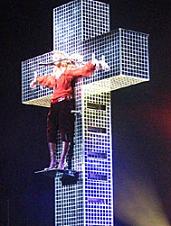 It’s happened to me many times—a mind-blowing coincidence will occur, and I’ll think, “If this happened in a movie or a book, it would be totally corny and unbelievable.” Which is why it takes such great skill to make coincidence unfold in fiction with authentic, goosebump-giving ease. This skill was sorely necessary in making the long-awaited film rendition of the novel “The Celestine Prophecy,” James Redfield’s bestselling (five million copies and counting) new age bible that revolves around notions of synchronicity, energy fields, and our overall cosmic connectedness.
It’s happened to me many times—a mind-blowing coincidence will occur, and I’ll think, “If this happened in a movie or a book, it would be totally corny and unbelievable.” Which is why it takes such great skill to make coincidence unfold in fiction with authentic, goosebump-giving ease. This skill was sorely necessary in making the long-awaited film rendition of the novel “The Celestine Prophecy,” James Redfield’s bestselling (five million copies and counting) new age bible that revolves around notions of synchronicity, energy fields, and our overall cosmic connectedness.
Like “The Da Vinci Code,” on paper Celestine was never known for its literary genius. But it was beloved for the way it named and played out new age spiritual beliefs in succinct, applicable ways. The allegorical adventure tale followed a school-teacher on his unlikely journey to Peru to help uncover and understand a manuscript that had been repressed and literally buried by the Catholic Church for hundreds of years. While there, he learned his way through the nine “insights” held in the scrolls, which included things like understanding “meaningful coincidences” as evidence of humanity’s quickly accelerating consciousness; knowing that subtle energies connect people and the natural world; and relating in a way that responsibly manages that energy for everyone’s good.
The screenplay, also written by Redfield, is relatively faithful to the book. An aloof teacher named John (woodenly played by a pretty, blank Matthew Settle) gets laid off, and meets up with an old girlfriend. She tells him about her recent trip to Peru, encouraging him to go because she thought of him the whole time she was there. She also works in an observation of his relationship issues: “You always want to have someone around because it makes you feel good,” she says, “but it doesn’t work out because you’re not really there.”
Most of the dialogue is equally brain-smashingly obvious. Then the coincidences begin in full: John goes home that night and a Peru brochure is mixed in with his other mail; he doesn’t see it yet, but a zooming, lingering camera makes sure we do. He discovers it the next day as he’s using a phone book to look up a travel agency (do either still exist outside of Hollywood?), while his decidedly current-day computer is sitting right there. And we hear him say to the agent, “Cancellation? Tomorrow? I’ll take it.”
Though the handling of synchronicity is blown, what the movie does better than the book are the scenes in Peru that show auras in action. We first see them as John hits on fellow scroll-studier Marjorie (Sarah Wayne Callies)—his reddish energy bubble starts trying to take over her energy bubble. Marjorie quickly runs off, and bewildered, John asks his guide, Julia, played by Annabeth Gish (of “Mystic Pizza” fame) what he did wrong. “Remember the halos the old masters used to paint around their religious figures?” she asks. “It’s the energy, John. You may not be conscious of it, but you were trying to take her energy. She could see it, and so could I.”
Unfortunately, that’s about as nifty as it gets (though the glowing plant-energy is pretty cool too). The rest is a preposterous unfolding of the insights, plus thriller-ish chases and violence by a church-fueled military. We’re supposed to see a transformation in John as he groks the insights, but not even his hair appears to change as he runs through the jungle for days. As now proven by both “Da Vinci” and “Celestine,” in book form it seems easier to overlook bad dialogue and poor character development to ferret out the juicy spiritual bits. The former is much harder to overlook—and the latter harder to seek—when the medium is a large, unforgiving screen that needs to satisfy in a couple of hours.


